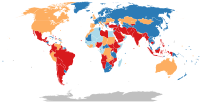
Photo from wikipedia
In most countries, attempts to reduce severe acute respiratory syndrome coronavirus 2 (SARS-CoV-2) circulation and new coronavirus disease 2019 (COVID-19) development have been mainly based on restrictive measures, including the… Click to show full abstract
In most countries, attempts to reduce severe acute respiratory syndrome coronavirus 2 (SARS-CoV-2) circulation and new coronavirus disease 2019 (COVID-19) development have been mainly based on restrictive measures, including the avoidance of social interactions, the prohibition of movements within the national territory, and the closure of all nonessential activities, including schools. While the closure of factories and the avoidance of other social interaction together with proper hand washing remain the best measures to reduce the total burden of COVID-19, the usefulness of school closure can be debated. It is highly likely that the most important reason leading governments to close schools was the evidence that the early introduction of this restrictive measure had been effective in reducing influenza incidence rates and related clinical, social, and economic problems during both seasonal and pandemic influenza outbreaks.1 However, it is not at all certain that the same advantages can be expected in the case of the COVID-19 pandemic. It is even possible that school closure may have negative effects and lead to greater medical, economic, and social problems. Modeling studies seem to indicate that school closure can be significantly effective for infection control only when the outbreaks are due to viruses with low transmissibility and attack rates are higher in children than in adults. This applies to influenza viruses and influenza infection but does not seem valid for coronaviruses, including SARS-CoV-2, which have different transmission dynamics, or for COVID-19, which affects mainly adults and elderly individuals. It has been calculated that the expected number of cases directly generated by 1 case of SARS-CoV-2 infection (R0) is high and not lower than 2.5.2 Moreover, children younger than 10 years account for only 1% of COVID-19 cases,3 and although a certain number of them can experience an asymptomatic infection, the total number of children with SARS-CoV-2 infection seems lower than expected. Although no official data are available, to our knowledge, on the effectiveness of school closure during the COVID-19 epidemic, the poor relevance of this restrictive measure seems confirmed by the evidence that in Taiwan, the spread of COVID-19 was minimized without widespread planned school closures.4 On the other hand, using UK population and school data together with data on SARS-CoV-2 transmission dynamics calculated in the early COVID-19 pandemic in China, it was predicted that school closure would be insufficient to mitigate the pandemic. Finally, the poor effect of school closure during coronavirus epidemics has already been evidenced in some studies carried out during the SARS epidemic. In China, it was found that school closure for 2 months was not significantly effective for disease prevention mainly because of the very low incidence of symptomatic disease among school-aged children.5 Moreover, in Taiwan, it was evidenced that the risk of transmission of infection among children in a classroom was very low, with an R0 less than 1, clearly highlighting that school closure could be only marginally effective.4 In a 2020 systematic review, Viner et al6 showed that there are no data on the relative contribution of school closures to SARS-CoV-2 transmission control. Data from the SARS outbreak in mainland China, Hong Kong, and Singapore suggest that school closures did not contribute to the control of the epidemic. Recent modeling studies of COVID-19 from the United Kingdom using data from the Wuhan province, China, outbreak predicted that school closures alone would prevent only 2% to 4% of deaths, much less than other social distancing interventions.7 While the efficacy of school closure is debatable, the potential negative consequences of this measure cannot be ignored. Some consequences regard the family. To take care of the youngest children when daycares and schools are closed, parents must remain at home, with inevitable economic consequences. In addition, when parents are health care workers, this can have relevant medical effects. In the US, it has been calculated that the absence from work of 15% of health care workers may be associated with a significant increase in COVID-19 mortality.8 If parents must work and grandparents must become the primary caretakers of children, the risk significantly increases that these persons, who are per se at the greatest risk of serious illness, may become infected, and this is what happened in Italy in the first 2 weeks when school closure was decided but other work activities were not stopped. Moreover, school closure can cause risks of deepening social, economic, and health inequities, particularly in limited-income countries. In the countries where the Ebola epidemic took place in 2014 to 2016, school closure was associated with increased child labor, violence, and socioeconomic problems.8 Finally, the distance learning through digital technologies that has been planned by several countries to replace traditional school can be difficult to implement even in some industrialized countries. In Italy, a 2015 survey carried out by the National Institute of Statistics9 showed that in the poorest areas of the country, 41% of the households did not have a tablet or a personal computer and that among families with at least 1 child, only 14.3% could guarantee distance learning. This means that a relevant group of children may remain substantially excluded not only from learning but also from any form of socialization with peers and with the surrounding world. VIEWPOINT
Journal Title: JAMA pediatrics
Year Published: 2020
Link to full text (if available)
Share on Social Media: Sign Up to like & get
recommendations!